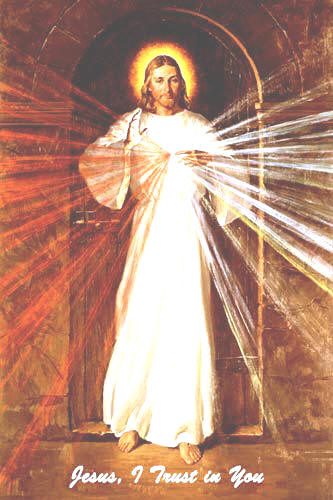“Skemp” Divine Mercy Image
This popular image is seen daily on TV in the EWTN Chapel. This image was commissioned to represent Jesus as walking through the door in the Upper Room and to have the rays going out in all directions. It was painted on wood in 1982 by Robert Skemp. The original painting was then given to Blessed Pope John Paul II who, in turn, then gave it to the National Shrine of The Divine Mercy in Tanzania.
Father Sopocko’s assistance in Kazimirowski’s creative process brought the first Divine Mercy Image to the world that same year . Other versions sprung into Church history at the hands of various artists over time, but Sopocko maintained that the Kazimirowski prototype, as he called it, was the ideal and most correct of any. “One needs very much to retain Sister Faustina’s mind,” he writes to Reverend Father Julian Chroschiechowski in 1956: “the walking position, the right hand not going above the shoulder, the eyes looking downward, the rays in the direction of the viewer, and not toward the ground as in the Lagiewniki image. [Sister] Faustina actually speaks of a pale [colorless] ray although sometimes she expresses herself that it’s white” (Stackpole, 83) .
Sopocko worked tirelessly to preserve and promote the authenticity of the first Divine Mercy Image. He openly opposed, for example, the version painted in 1942 by Adolf Hyla, a neighbor of the Sisters of Our Lady of Mercy in Lagiewniki, considering it overly feminine, at variance with clear details that Faustina provided many years prior, and having an inappropriate, illogical background. Hyla offered to paint the image for the sisters to thank them for aiding his family in the turmoil of war, and it remains today a very popular painting. From Mother Superior Irena Kryzanowska, he received a reproduction of the Kazimirowski version and a description of the revelation of Jesus. Guided also by Sister Faustina’s first spiritual director, Reverend Joseph Andrasz, S.J, the Cracovian artist painted a fourth successor to the Divine Mercy Image and saw it solemnly blessed in the sisters’ convent at Lagiewniki.
A fifth version, called the Sledzinski image, Father Sopocko himself instigated as with every effort he sought to demonstrate the image’s association with public revelation. Their Excellencies the Bishops decided in 1953 to prohibit the exposure of the Divine Mercy Image in churches so as not to anticipate the Holy See’s decision regarding the authenticity of private revelation. Sopocko in turn projected the image as representing Christ in the moment of instituting the Sacrament of Divine Mercy (of Penance) in the Upper Room (John 20: 19 ff). Consonant with Sister Faustina’s own thoughts, he provided the doors of the Cenacle for a background, and Professor Ludomir Sledzinkski accomplished a new painting according to the Kazimirowski prototype. Though more feminine than Father Sopocko cared to see, the Sledzinkski image depicts Christ at the time of His institution of the Sacrament of Penance when, to all present, Our Lord uttered “Peace to you!” In it, the Principle Episcopal Commission first saw the Divine Mercy Image as being a visual commentary on the liturgy – particularly the liturgy of Low Sunday, the Sunday following the Resurrection of Christ. The Commission thereafter approved Divine Mercy as stemming from public revelation, though on condition that the image remain disconnected from private revelation until verified by the Apostolic See in that regard. The story of the Image of the Merciful Jesus, at least this portion, closes here on the sixteenth anniversary of Sister Faustina’s death in 1954.http://mercyimages.com/history_divine_mercy_image.php

No comments:
Post a Comment